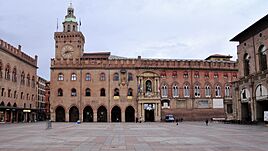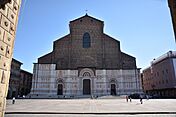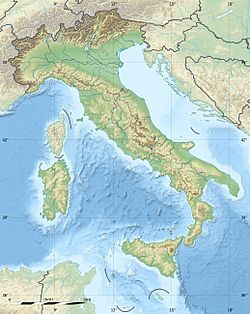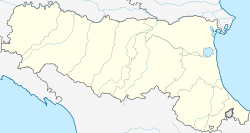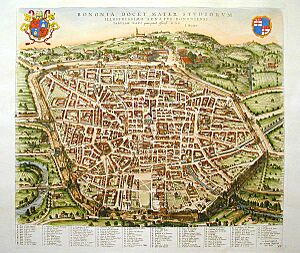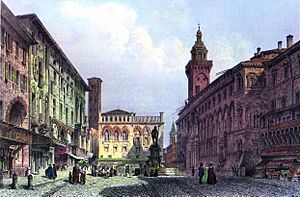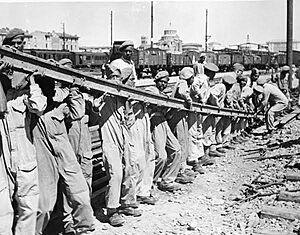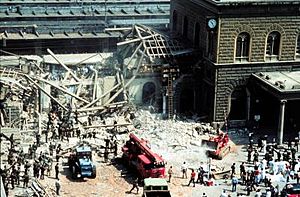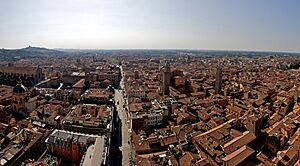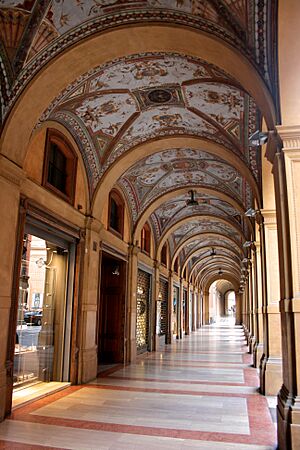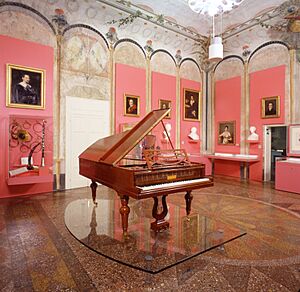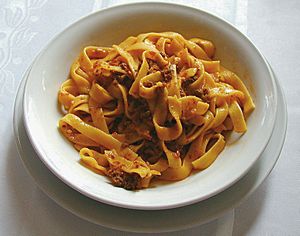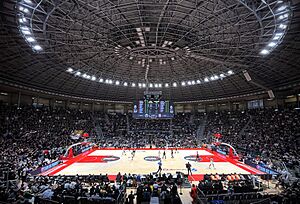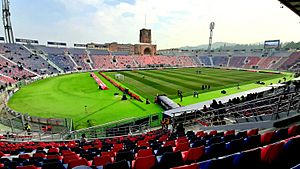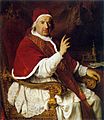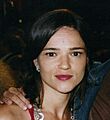Bologna facts for kids
Quick facts for kids
Bologna
Bulåggna (Emilian)
|
|||
|---|---|---|---|
| Comune di Bologna | |||
|
Piazza Maggiore
Due Torri
San Petronio
Piazza Santo Stefano
Madonna di San Luca
|
|||
|
|||
| Country | Italy | ||
| Region | Emilia-Romagna | ||
| Metro | Bologna (BO) | ||
| Government | |||
| • Body | Bologna City Council | ||
| Area | |||
| • Comune | 140.86 km2 (54.39 sq mi) | ||
| Elevation | 54 m (177 ft) | ||
| Population
(31 August 2020)
|
|||
| • Comune | 394,843 | ||
| • Density | 2,803.09/km2 (7,259.97/sq mi) | ||
| • Metro | 1,017,196 | ||
| Demonym(s) | Bolognese | ||
| GDP | |||
| • Metro | €39.502 billion (2015) | ||
| • Per capita | €38,918 (2015) | ||
| Area code(s) | 0039 051 | ||
| Click on the map for a fullscreen view | |||
Bologna is a famous city in northern Italy. It's the capital of the Emilia-Romagna region. About 400,000 people live here, coming from many different countries. The wider area around Bologna is home to over 1 million people.
Bologna is super famous for having the University of Bologna, which is the oldest university in the world that's still running! It started way back in 1088. The city has a long history, starting with the Etruscans, then the Celts, and later the Romans.
Today, Bologna is known for its tall towers, beautiful churches, and long covered walkways called porticoes. The city center is very well-preserved. In 2000, Bologna was a "European Capital of Culture." Later, in 2006, UNESCO named it a "City of Music." In 2021, the city's amazing porticoes became a World Heritage Site.
Bologna is also a busy place for business. It's a big center for farming, factories, money, and transportation. Many large companies that make machines, electronics, and food are based here. It also has one of Europe's biggest trade fairs. Bologna is working to become carbon neutral by 2040. This means it wants to stop adding greenhouse gases to the atmosphere.
Contents
History of Bologna
Bologna has a very long and interesting past. It has been an important city for thousands of years.
Ancient Times and the Middle Ages
People have lived in the Bologna area since about 3000 BCE. Around 900 BCE, the Villanovan culture thrived here. Later, the Etruscans built a city called Felsina in the 6th century BCE. Then, the Gaulish Boii tribe took over. In 196 BCE, the Romans made it a colony named Bonōnia.
When the Roman Empire was ending, Bologna was attacked many times. A legendary bishop named Petronius helped rebuild the city. He is now the patron saint of Bologna.
In 727, the Lombards took control of Bologna. They built a new part of the city. Later, in the late 700s, Charlemagne took over the Lombard kingdom. Bologna then became part of his empire and grew stronger.
The University of Bologna started around 1088. It became famous for studying law. Important thinkers like Dante and Petrarch studied there. By 1200, Bologna was a busy city with about 10,000 people.
In 1249, King Enzo of Sardinia, son of Emperor Frederick II, was captured by Bologna's forces. He was kept prisoner in a palace now called Palazzo Re Enzo for over 22 years.
The late 1200s were a time of fighting between powerful families in Bologna. This made the city weak. In 1348, the Black Death plague hit, cutting the city's population in half.
Bologna was ruled by different groups over the next centuries. Sometimes it was independent, and sometimes it was controlled by the Pope or Milan. In 1506, Pope Julius II took full control of the city.
Early Modern Period
From 1506 to 1796, Bologna was ruled by the Pope. In 1530, Emperor Charles V was crowned in Bologna. This was the last time a Holy Roman Emperor was crowned by the Pope.
During this time, important buildings like the Piazza del Nettuno and the Archiginnasio (the main university building) were built. Many churches were also constructed or restored. Bologna had more convents than any other Italian city. Famous painters like Annibale Carracci came from Bologna during this period.
However, by the late 1500s, Bologna started to decline. Plagues in the 16th and 17th centuries greatly reduced the population. The city's economy also struggled as trade shifted to other parts of Europe. The university lost students because of the Church's strict rules on learning.
In the mid-1700s, Pope Benedict XIV, who was from Bologna, tried to help the city. He made some reforms to boost the economy and arts. But these changes had mixed results.
Modern History
In 1796, Napoleon took over Bologna. After Napoleon's fall, Bologna went back to being ruled by the Pope in 1815. But people wanted more freedom. There were uprisings in 1831, but Austrian forces helped the Pope stop them.
By the 1840s, many people in Bologna were poor and unemployed. In 1860, Bologna voted to join the new Kingdom of Italy. This helped the city's economy grow again. Bologna became an important railway hub.
After World War I, Bologna saw many socialist protests. Later, the city supported the Fascist movement led by Benito Mussolini. During the years between the world wars, Bologna became a major center for making food, farm machines, and metal products.
World War II in Bologna
Bologna was badly damaged during World War II. It was an important target for Allied forces because it was a key railway and industrial center. In 1943, big air raids destroyed much of the city center and killed many people. The main train station was hit hard. By the end of the war, almost half of Bologna's buildings were damaged or destroyed.
After Italy's armistice in 1943, Bologna became a center for the Italian resistance movement. These brave groups fought against the Fascist and Nazi forces. On April 21, 1945, resistance fighters entered Bologna. Soon after, Allied forces, including Polish troops, arrived, and the city was freed.
Cold War Period
After the war, Bologna became a busy industrial city. It was also a strong base for the Italian Communist Party. For many years, the city had mayors from this party.
In 1977, there were some street clashes in Bologna. On August 2, 1980, a terrible bomb attack happened at the central railway station. This event, known as the Bologna massacre, killed 85 people and injured 200. It was a very sad day for Italy. Every year on August 2, people in Bologna remember this event.
Bologna in the 21st Century
In 1999, Bologna elected a mayor from a different political group, ending a long period of left-wing leadership. But in 2004, a center-left mayor was elected again. The current mayor, Matteo Lepore, was elected in 2021. He is very popular and wants Bologna to be a sustainable and fair city.
Geography of Bologna
Bologna is located at the edge of the Po Plain, right where the Apennine Mountains begin. It sits where the Reno and Savena rivers meet. The city center is about 54 meters (177 feet) above sea level. The highest point in the wider Bologna area is Corno alle Scale, which is 1,945 meters (6,381 feet) high.
Bologna's Climate
Bologna has a climate with four distinct seasons. Summers are warm, and winters are cool. It usually rains most in spring and autumn. Snow can fall between late November and early March.
Cityscape and Landmarks
Bologna has one of Europe's largest historic centers. It covers about 350 acres (1.4 square kilometers). Even though it was bombed in World War II, it still has many important medieval, Renaissance, and Baroque buildings.
The main street, Via Emilia, runs straight through the city. Bologna's central streets follow a grid pattern, like a Roman city. In the Middle Ages, Bologna had many defensive towers, maybe up to 180! Today, only about 20 remain. The most famous are the Due Torri (Asinelli and Garisenda). They lean, making them a popular symbol of the city.
Bologna is also famous for its beautiful and long porticoes. These are covered walkways that line the streets. There are about 38 kilometers (24 miles) of porticoes in the city center. They let you walk long distances while being protected from the weather.
The Portico di San Luca is probably the longest in the world. It's almost 4 kilometers (2.5 miles) long. It connects the city to the Sanctuary of the Madonna di San Luca. This church is on a hill overlooking the city and is a major landmark. Every year, a traditional procession carries a special icon of the Madonna with Child along these porticoes. In 2021, these porticoes became a UNESCO World Heritage Site.
The San Petronio Basilica is a huge church built between 1388 and 1479. It's one of the largest churches in the world. The Basilica of Saint Stephen is even older, dating back to the 8th century. The Basilica of San Domenico is a 13th-century church with beautiful tombs. Other amazing churches include St Francis, Santa Maria dei Servi, and San Giacomo Maggiore.
Bologna's Economy
Bologna has a strong economy. In 2017, the wider Bologna area produced about €35 billion (around $40.6 billion) in goods and services. This makes it one of the richest areas in Italy.
Bologna's economy is known for its factories. They make things like food products, machinery, construction equipment, and cars. Famous brands like Ducati (motorcycles) and Lamborghini (sports cars) are based nearby. Bologna is also known as the "packaging valley" because many companies that make automatic packaging machines are here.
The city also has many cooperative businesses. These are businesses owned and run by their members. This tradition goes back to the 1800s. Today, these cooperatives create a lot of jobs in the region.
Transportation in Bologna
Bologna is a major transport hub in Italy. It has the Bologna Guglielmo Marconi Airport, which is one of Italy's busiest airports.
Bologna Centrale railway station is one of Italy's most important train stations. It connects routes from north to south and east to west. Over 58 million passengers use it every year. The city also has many bus and trolleybus lines. A new tramway system is currently being built in Bologna.
Public Transport Facts
On average, people in Bologna spend about 53 minutes traveling on public transport each weekday. About 9% of riders travel for more than 2 hours a day. The average wait time at a stop is 12 minutes. The average distance for a single trip is about 5.4 kilometers (3.4 miles).
Population of Bologna
At the end of 2016, Bologna had about 388,254 people living in the city itself. The wider Bologna area has about 1 million people. The population of Bologna is a bit older than the Italian average. About 12.86% of the population are minors (under 18), while 27.02% are pensioners.
Education in Bologna
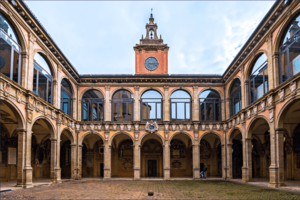
The University of Bologna is thought to be the oldest university in the world that is still operating. It was founded in 1088. It was a very important center for learning in the Middle Ages. Many famous scholars came from all over Europe to study here.
The university started as a group of teachers, with each teacher collecting fees from students. So, the university buildings were spread out across the city. Later, in the time of Napoleon, the main university moved to its current location.
Today, the university has many schools, departments, and libraries all over the city. It also has campuses in nearby towns. Famous students from the past include Dante, Petrarch, and Copernicus. Laura Bassi became the first woman to officially teach at a European university in 1732. More recently, Luigi Galvani (who discovered bioelectricity) and Guglielmo Marconi (who helped invent radio) also worked at the university.
Bologna is still a big university town. In 2015, over 80,000 students were enrolled. Many of these are international students. The university's botanical garden was started in 1568, making it the fourth oldest in Europe.
Other universities also have campuses in Bologna, like Johns Hopkins University. The city also has a music school, Conservatorio Giovanni Battista Martini, and an art school, Accademia di Belle Arti di Bologna.
Culture of Bologna
Bologna has many nicknames! "The fat" (la grassa) refers to its amazing food. Bologna is famous for rich meats, egg pasta, and dairy products. "The red" (la rossa) first described the color of the city's buildings. Later, it also referred to the city's strong support for communist ideas after World War II.
Another nickname is "the towered" (la turrita), because of the many medieval towers. And "the learned" (la dotta) refers to its very old and famous university.
University Life
Bologna's university is the oldest in the world. It's ranked as one of the top universities in Italy and the world. The huge number of students from all over the world makes Bologna a lively place. It brings energy to the city center and helps with cultural events.
Music and Arts
Bologna became a UNESCO City of Music in 2006. UNESCO recognized its rich musical history and how music helps bring people together. Bologna has many types of music, from classical to jazz and opera.
Theater has been popular in Bologna for centuries. The city has many theaters that offer different kinds of shows. Bologna's opera house is the Teatro Comunale di Bologna. The city also hosts many international festivals for music, art, dance, and film. These include the Bologna Jazz Festival and Il Cinema Ritrovato (a film festival for rare movies).
Bologna's Delicious Food
Bologna is famous for its food! It's the home of the well-known Bolognese sauce. In Italy, this meat sauce is called ragù. It's usually served with tagliatelle, a type of flat pasta. Serving it with spaghetti is not common in Bologna.
The local food uses a lot of meats and cheeses. Bologna is known for cured pork meats like prosciutto and mortadella. Local specialties include tagliatelle with ragù, tortellini (small pasta rings) served in broth, and lasagna.
Traditional desserts are often made for holidays. These include fave dei morti (almond cookies) for All Saints' Day and sfrappole (fried pastries) for Carnival. Torta di riso, a rice and almond cake, is enjoyed all year round.
Sports in Bologna
In Bologna, basketball is the most popular sport, which is unusual for Italy! The city is even called Basket City. This is because of the success of its two rival basketball clubs, Virtus and Fortitudo. Virtus Bologna has won many Italian and European championships, making it one of Europe's top basketball clubs.
Football is also very important in Bologna. The city's main club, Bologna FC 1909, has won seven Italian league championships. They play at the Stadio Renato Dall'Ara, which has hosted international football and rugby games.
Rugby union also has a long history in Bologna. Rugby Bologna 1928 is one of Italy's oldest rugby clubs. The Gianni Falchi Stadium is a baseball stadium in Bologna, home to the Fortitudo Baseball Bologna team.
Famous People from Bologna
Many notable people were born in Bologna or made it their home.
- Maria Gaetana Agnesi (1718–1799), a mathematician.
- Francesco Albani (1578–1660), a Baroque painter.
- Laura Bassi (1711–1788), the first woman to officially teach at a university in Europe.
- Pope Benedict XIV (1675–1758), a Pope who tried to help Bologna.
- Annibale Carracci (1560–1609), a famous painter.
- Luigi Galvani (1737–1798), a scientist who discovered bioelectricity.
- Pope Gregory XIII (1502–1585), a Pope who created the Gregorian calendar.
- Guglielmo Marconi (1874–1937), an engineer who helped invent wireless radio. He won a Nobel Prize.
- St. Petronius (died around 450 AD), the patron saint of Bologna.
- Romano Prodi (born 1939), an economist and politician who was Prime Minister of Italy.
- Gioachino Rossini (1792–1868), a famous opera composer.
- Alberto Tomba (born 1966), a well-known skier.
- Alex Zanardi (born 1966), a racing driver.
International Connections
Bologna is twinned with several cities around the world. This means they have special friendly relationships to promote cultural and economic ties.
- Coventry, England, UK
- Kharkiv, Ukraine
- Leipzig, Germany
- La Plata, Argentina
- Portland, Oregon, United States
- Saint-Louis, Senegal
- St. Louis, United States
- Thessaloniki, Greece
- Toulouse, France
- Tuzla, Bosnia and Herzegovina
- Valencia, Spain
- Zagreb, Croatia
Images for kids
See also
 In Spanish: Bolonia para niños
In Spanish: Bolonia para niños


